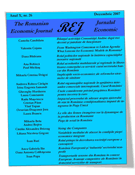Abstract:
The quality of mortgage loans had been deteriorating since 2001, when interest rates were consistently below 3 per cent for several years. Housing prices dropped substantially since their high in 2006. This article examines the current credit crisis against the background of recent financial meltdowns in wealthy and emerging markets. We argue that securitisation involves various tensions between market participants and is based on several different criteria that gauge liquidity and creditworthiness. Most often, liquidity and credit enhancement are part of the deal. The problems in the subprime market led directly to the Fed Rescue, in which it guaranteed $30 billion, although Fed's authority over investment banks is murky. The United States had been experiencing subprime crisis, and that affect EU ’s policies on interest rates and exchange rates. The situation also influence Romanian creditors to study more closely a borrower's capability to pay the loan. The possible implications of the U.S. subprime crisis on EU's public equities, hot money, domestic credit, and exports are discussed in the following article.
